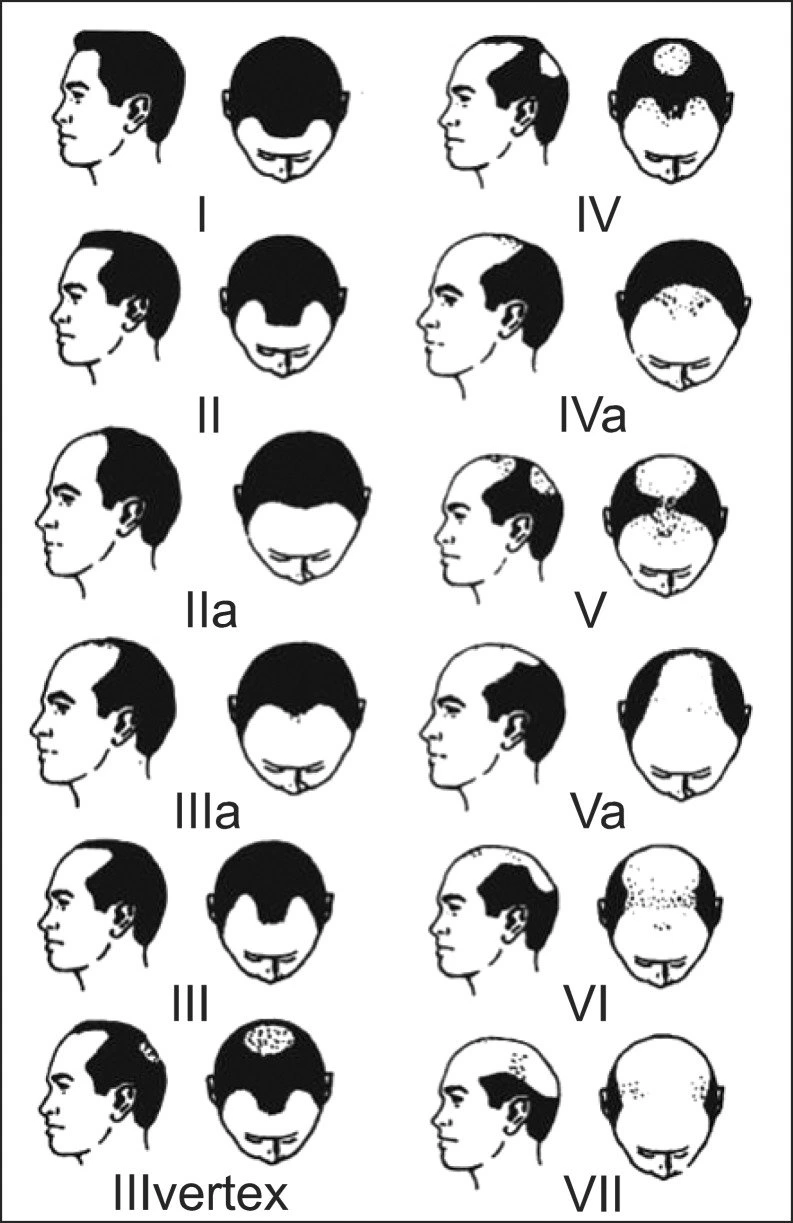You just have to decide about getting your confidence back with dense hair & we assure you about the quality of treatment & the post-surgery results, which are excellent, always. We use a multi-therapy option, post-hair transplantation to boost the results.
Before you look for the solution to your baldness, you must refer to the chart below. Telling the baldness type to your consultant can help him/ her understand your level & can guide you accordingly. Required grafts & the cost completely depend upon the level of baldness.

As per the reports of the International Society of Hair Restoration Surgery, hair loss is known to adversely impact 21 million women only in the United States, with a distinguishing effect on their social, emotional, psychological, and of course physical well-being.
Society usually has very less acceptance of thinning hair or baldness in both men & women as it is considered to be one of the element that defines and enhances the beauty or looks naturally.
It is the only permanent solution to the hair loss & can cover the large area in a natural way.
Results or restored hair are not only natural looking but we can also achieve designer hairline with hair transplant at Cult Aesthetics.
The procedure is simple, painless, & has minimum downtime.
FUT: The widely used technique for hair transplantation is follicular unit transfer or FUT which is also known as “strip harvesting”.
FUE: During an FUE procedure, each follicular unit or graft is removed from the back and side of the scalp (donor site) one at a time.
Treatment Options
Hair transplant aka Hair replacement or Hair restoration is a kind of surgery that shifts hair from the part that is resistant to hair fall and already has hair i.e. the donor site to fill the area of the scalp that has thin or no hair i.e. the recipient site.
The hair transplant treatment restores hair by cultivating follicles into thinning or balding areas of the scalp.
The procedure involves planting follicular units (the natural bundling of one to four hairs) from the back or side of the head, which is regarded as the donor site due to its attribute of being resistant to hair loss or even DHT – Dihydrotestosterone a hormone known to be the main stimulator of hair loss, baldness and hair thinning among men and women.
In the United States, dermatologists and hair professionals have been performing hair transplant procedures since the 1950s, and have yielded amazingly positive results hence its emerging success led to its inception in India a few years back.
People undergone hair transplantation surgical procedure in India has shown remarkable results when got it done by highly experienced and skilled hair and skin experts.
The techniques performed by the experts in India are cutting-edge and technically upgraded as things have changed a lot in recent years.
A patient for a hair transplant always has the treatment in the doctor’s clinic. The doctor begins by cleaning the scalp and injects medicine to anesthetize the back of the scalp.
The dermatologist would choose from one of two methods for the hair transplant: follicular unit extraction (FUE) and follicular unit transfer (FUT) or aka strip surgery.
After the hair transplant surgery, the patient’s scalp may be very tender. You may require consuming pain-relieving medications for some days. The doctor will keep you wearing bandages over your scalp for almost a day or two.
Your doctor may also have you an antibiotic or an anti-inflammatory medication to take for a few days post-surgery. Most people are able to resume work and routine life 2 to 4 days after the operation.
Within 15-20 days after the surgery, the implanted hair will shed out, but you should begin to notice fresh growth within a few months. Most patients will notice about 60% of new hair growth after 6 to 9 months.
The cost of a hair transplant depends largely on the no. of grafts you are transplanting, but it usually varies from Rs. 20,000 to Rs. 3,00,000.
The cost totally depends upon the no. of grafts required to cover the bald area. The cost of the graft may vary from Rs. 20 to Rs. 45. This cost varies on the experience, skills, reputation, and clinic location of the doctor.
As with any type of surgery, hair transplants have few risks, including infection and bleeding. It is also possible to have unnatural-looking new hair growth and scarring.
Around the time new manes begin to grow, some people may have an infection or inflammation of the hair follicles, called folliculitis. Antibiotics and compresses can dissolve the issue.
There is also the chance of suddenly losing some of the original hair in the region where you got the grafting, called shock loss. But there is nothing to worry about as most of the time, it is just temporary.
The initial consultation caters as an introduction to the patient’s hair loss concerns; hair loss pattern and family/medical history.
At the time of the consultation, an initial examination is conducted, and the requirement for blood tests, scalp biopsy, or microscopic assessment of the hair shafts is confirmed.
If the actual cause of hair loss is not verified, further diagnostic details are gathered from agronomy for scalp fungus, and scalp scrapings; as well as blood tests and/or a scalp biopsy.
The diagnosis is established based on the hair loss presentation, pattern, history, and where requisite supplementary distinctive inspections. In many cases, there may be no surgical invasion needed.
Male Pattern Hair Loss (MPHL) is diagnosed when there is a history of hairline recession and hollow temples. The thinning or hair loss in men is evident with an M-shaped pattern where both the front sides start to recede back, thus creating an M-shape.
Gradually this thinning increases with presenting hair loss on top of the scalp. Some Men in their 20s or mid-20s could become victims to Androgenic Alopecia and start seeing such hair loss.
“Female pattern” hair loss (FPHL) is diagnosed when there is a history of steady thinning in the front and/or top of the scalp. In most females, the frontal hairline is most often preserved.
The thinning is usually centrifugal (compacted to the central top area of the scalp) in characteristic, and there is generally a genetic disposition or family history of hair loss.
Some women may show a continually widening part. For women, the development of androgenic alopecia is categorized into 3 stages. The standard pattern of hair loss in women is continuing diffuse thinning in an oval region along the top of the scalp.
Hair loss along the hairline is most often excused. Miniaturization of the hair follicles with declined hair shaft caliber will be noticed in the thinning regions of the scalp.
Diffuse hair loss all through the head can make for a more complex diagnosis, but miniaturization generally means that the cause is most possibly due to female pattern hair loss or androgenetic alopecia.

Cult Aesthetics is a Cosmetic Surgery chain based in Gurgaon & Delhi. Our journey began in 2019 and under Dr. Gaurav Solanki’s leadership and within a span of 3 years we’ve built a name that many centres seldom make in a decade!
Read more